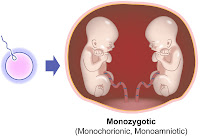What are MoMo Twins?
MoMo twins are by definition identical. Identical twins are formed when a single fertilized egg splits in the womb. If the egg splits prior to the placenta being formed each embryo has its own placenta, chorionic sac, and amniotic sac. If the split occurs after the placenta has begun to form (typically 7-9 after conception) the twins begins to form in the same placenta and sacs.
Identical Twins

Monoamniotic Monochorionic Twins
Why are MoMos special?
Besides being a rare occurrence (less than 5% of identical twins pregnancies), momo twins are at risk for health complications due to the close proximity of their umbilical cords in the amniotic sac.
What are the concerns for the twins?
Momo twins are at risk for cord entanglement, cord compression, and twin to twin transfusion.
Cord Entanglement - Because the twins have no membrane separating them their umbilical cords can be easily tangled. Actually, most MoMo twins cords are tangled at some point in during the pregnancy, but severe entanglement can cause fatal complications
Cord Compression - Without a membrane separating them as the twins move around in their sacs, one can compress the other's cords cutting off nutrients and blood flow.
Twin to Twin Transfusion - This occurs when one twin receives the majority of the nourishment in the womb causing the other undernourished and sickly.
What can be done to help ensure a healthy babies and mom?
First recognizing that carrying multiples is different from carrying a singleton. May seem obvious, but the needs are different and not always proportional. Secondly, very little until viability (24 - 26 weeks). Intensive monitoring of fetal movement, blood flow between the cords and development prior to viability and then increasing post viability.
How does this affect your pregnancy?
My pregnancy is officially considered high risk. I see my doctor's on average of every 2-3 weeks during the 1st part of pregnancy increasing to 2-3 times a week as my pregnancy progresses. I get to see the twins often with ultrasounds at every appointment. Once the twins reach viability I will start with home monitoring 2-3 times a day and multiple weekly ultrasounds to monitor blood flow and development. At some point yet to be determined, I will enter the hospital for 24/7 monitoring.
What about delivery?
MoMo twins are typically born between 32-34 weeks barring any complications. Due to cord entanglement they are born via c-section. Due to their premature arrival, most spend period time in the Neonatal Intensive Care Unit (NICU).





No comments:
Post a Comment